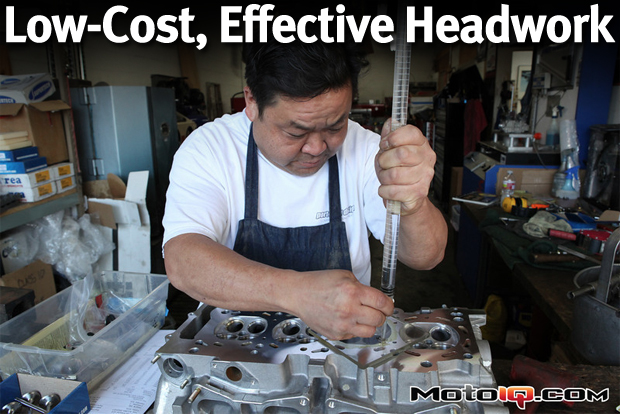,
 |
| There were no new stock SR20VE valves available in the country so we had to turn to the aftermarket. The SR20VE has a shorter stem and different keeper groove locations than the SR20DE valve so we had to use Supertech inconel exhaust valves. Inconel, an exotic heat resisting and conducting alloy of nickle and copper is probably an overkill for our engine but oh well. The valves were 2mm oversize, too big for our stock bore so Tom Fujita of Portflow Design turned them down to 1mm oversize. We reused the stock intake valves because they were in excellent shape. |
The Supertech valves have a reduced diameter stem near the head for better flow and swirl polishing which also improves flow. Inconel is a tough, highly heat resistant alloy of nickle and copper which is usually reserved for turbocharged engines. It should be way more than fine in our very mild NA engine under any conditions. We’ll probably never need to worry about our valve losing its head again.
 |
| We had planned to shoot more pictures of how Tom did all of this work but he did the head so fast, we were too late. Flaky head porters have frustrated all of our engine building projects but Portflow Design sticks to schedule and knocks the work out in a very reasonable time frame. Tom did a radius valve job on the intake and exhaust. You can see in this picture how the throat and chamber cuts are smoothly blended into the combustion chamber and port. This is quite awesome for flow. You can also see how the valve seats are opened up to 90% of the valve size blended into the port as well. The rest of the port was left stock. This minor work can make quite a difference in power. We are hoping that this can give us a broader powerband since we are not enlarging the ports at all. Tom unshrouded our valves by grinding back our combustion chamber to the gasket line and removed all sharp edges that could cause pre ignition from the chamber. |
After working over our valves, Tom opened up our valve seats. Typically you want your entrance to the exhaust port starting from the bottom cut of the valve job to be 90 percent of the diameter of the valve. The stock valve seats typically have less than 80 percent of the diameter, a significant choke point. The reason for this is that mass production engines just have the valve seats pressed in, then a valve job cut and thats it. Hand finishing this area would greatly add to the cost of a mass produced engine.
 |
| Tom then cc’ed our head so we could calculate our true compression ratio. He started by laying this plexiglas plate over the chamber, sealing the plate to the deck surface with grease. He sealed the valves with grease as well. |
Tom used a die grinder to open up our seats by hand. At the same time Tom also blended the enlarged seats into the port wall opening up the ports in the bowl area. During this operation Tom reduced the sharp edge in the short side radius of the port where the valve seat meets the floor of the port.



